This post contains affiliate links. We may get paid an affiliate commission if you buy something or take an action after clicking one of the links on this web page.
One of the biggest events of the year for knife nuts is Blade Show. Put on by Blade Magazine, this industry wide convention draws a cavalcade of steel-toting enthusiasts to Atlanta, Georgia, where custom knives are fought over and new production designs are revealed. For the last several years, their Overall Knife of the Year award has been granted to blades that are…let’s say, of questionable utility. Beautiful, and without a doubt technical marvels, but they bear more resemblance to concept cars than to utility vehicles. To find designs that are within the reach of the hoi polloi, one should look at some of the more obscure awards, which focus on budget, innovation, and place of origin.
This review focuses on one such design: the Spyderco Manix 2 Lightweight, which won the 2010 Blade Show award for Most Innovative American Design and has since garnered quite a bit of critical praise. Nowadays, the Manix is seen as part of the vanilla Spyderco line, but that’s not how it’s always been. At the time, it seemed like the Manix was the way of the future. Thin, fully flat ground blade? Check. Thumb hole? Check. Innovative lock that kept your fingers clear of the blade? Also, check. That all of these features are found at a pretty economical price point and on a blade that’s made in the U.S.A. is impressive today, but was a much bigger deal when the question of the day was Benchmade vs. Spyderco.
General Dimensions and Blade Details
The Spyderco Manix 2LW measures just over 8” overall, with a 3.37” blade and a 4.66” handle. The Manix 2 LW is made in the USA. As its name would imply, the Manix 2LW doesn’t weigh much – only 2.9 oz. – a weight that’s pretty remarkable for a knife this size. It’s worth mentioning that the cutting edge is actually 2.88” because of the inclusion of a 50/50 finger choil. I applaud that decision. Spyderco is famous for their ergonomics, and the finger choil is part of that recipe.
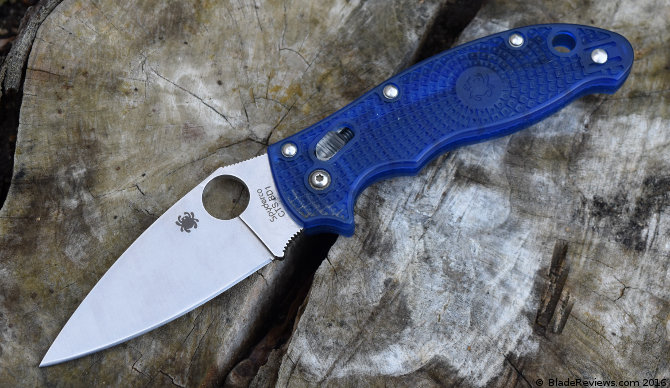
Spyderco chose Carpenter’s BD1, a relatively unknown steel, for the lightweight version of the Manix 2. According to the data sheets, BD1’s performance should be the equivalent of high quality 440c. Most online feedback indicates the same. In my experience, it’s been difficult getting the BD1 as sharp as I’d like. Its edge retention isn’t the best, and requires regular maintenance. If there is one attribute it excels at, it is corrosion resistance. I’ve forgotten to clean this knife after cutting citrus before, but even that didn’t leave so much as a mark.
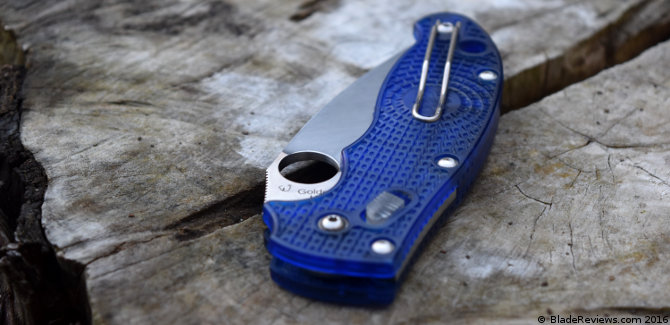
For all the questions about the blade steel, Spyderco hit it out of the park with the blade shape (and grind). The leaf-shaped blade is a mainstay in their product line and never disappoints. When paired with a full flat grind and fairly thin stock (.125”), you’re almost guaranteed success. Extensive use in the kitchen and the field bears that assumption out. My sharpening issues aside, the blade performs very well. The smokey mirror finish Spyderco put on the Manix is easy to clean and doesn’t attract fingerprints like a higher polish would.
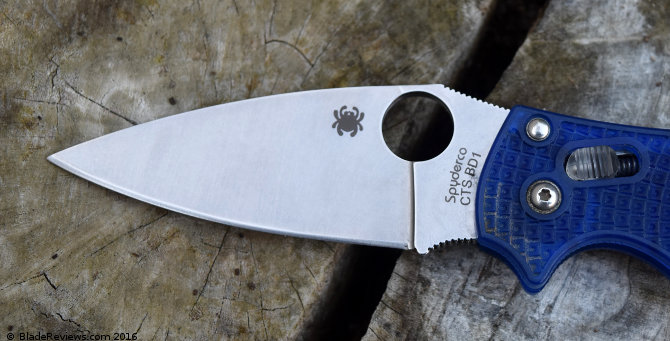
Handle, Ergonomics, and Carry
The handle on the Manix 2 Lightweight is made of fiberglass reinforced co-polymer, or FRCP. It is very similar to the fiberglass reinforced nylon (FRN) Spyderco uses on the Delica/Endura/etc. When compared side by side, FRCP is stiff, while FRN has a bit of give to it (akin to rubber). I own knives with both as handle materials, and I don’t know if I have a preference. As with any plastic handle, there will be folks who complain about the material feeling cheap, but I don’t mind it. I prefer the translucent blue handle over the black handle. This knife is very well-suited to backpacking, and a bright handle helps ensure that your knife doesn’t get lost among the foliage.
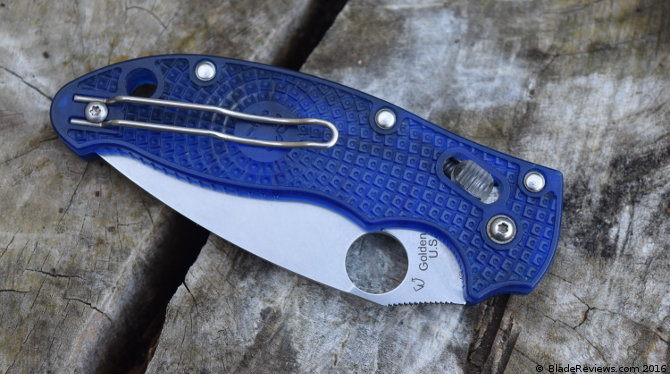
I’ve found the ergonomics to be just as good as I’d expect from an in-house Spyderco design (read: excellent). Some folks complain that the handles are too blocky. Those people need to find something else to complain about, because I could not find a fault with the ergonomics. The 50/50 finger choil allows the user to choke up for better push cuts, while the rear grip is well-suited for slicing and draw cuts. Spyderco’s bi-directional grip pattern is very effective at gluing your palm to the handle without being abrasive. I will say I could do without the jimping on the interior of the handle.
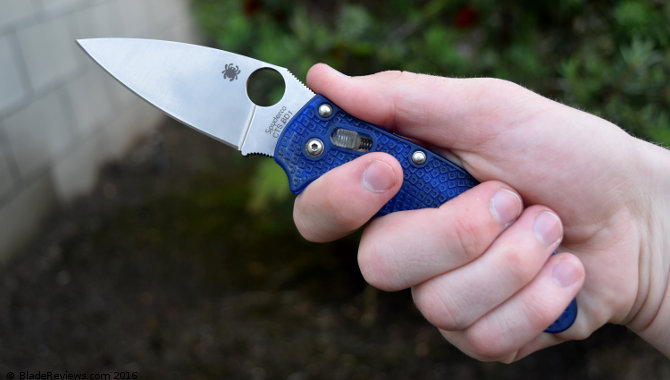
Spyderco’s wire clip seems to be pretty polarizing, at least if you take online comments seriously. Some love it because it’s discrete, doesn’t generate a hotspot, and doesn’t shred the edges of your pocket. Those who hate it complain that the wire clip wiggles around and doesn’t offer enough tension to keep the blade secure in the pocket. I’m in the former camp; every wire clip I’ve handled has had plenty of tension, and I prefer the practical advantages outlined above. Between the low weight and excellent clip, this knife is a dream in the pocket (particularly for its size).
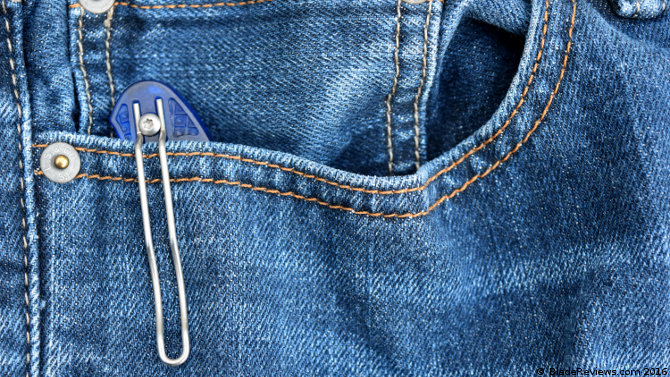
Deployment and Lock-up
I’ve mentioned this before, but the knife market is almost exclusively focused on flippers right now. Personally, I’ve always preferred the thumb hole as a deployment method. They’re just as easy to flick, but much better when it comes to slow-rolling the knife open. I also don’t wear my fingers out fidgeting with Spydercos the same way I do when I’m messing around with a flipper. This is a very nice execution of the thumb hole. At 14mm, it’s large enough that opening the knife is never a problem, even while wearing gloves. The interior of the cut out has been nicely polished and slightly chamfered.
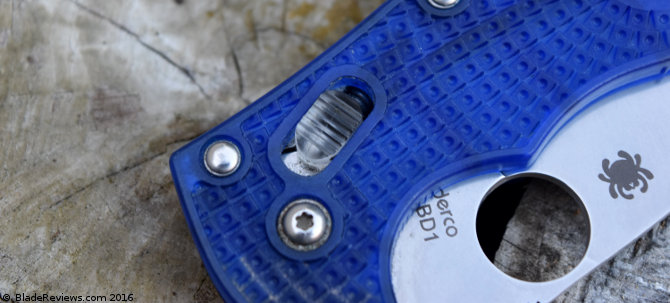
If it wasn’t for the lock, I probably wouldn’t like this knife as much as I do. The Manix is equipped with the Caged Ball Bearing Lock, which is frequently compared to Benchmade’s Axis Lock and SOG’s Arc Lock. All three offer ambidextrous manipulation of the lock without putting your fingers in the path of the blade. Out of the three, the CBBL is my favorite. It fixes the one problem that I have with the other offerings: a weak detent. On the Manix, the detent is not only quite firm, but crisp as well. There’s a level of security knowing that the blade isn’t going to flop open with a wave of the hand.
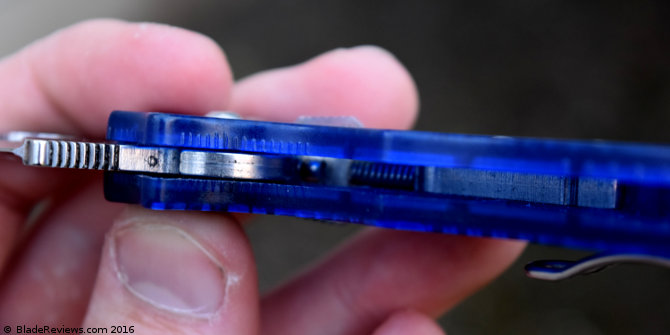
Spyderco Manix 2 Lightweight Review – Final Thoughts
My thoughts on the Manix 2LW are generally positive. If it weren’t for my issues putting a keener edge on the BD1, I’d carry it more frequently than I do now. Even with that handicap, it’s a great knife. The Manix 2 LW is available at most retailers for around $80.00. If you’re worried about the steel (my experience seems to be an outlier), Spyderco also offers the Manix 2LW in CPM-S110V for around $35 more.
That aside, the Manix is arguably in an awkward spot on the product line. For a relatively small amount of money, you could instead purchase a Paramilitary 2, which is widely regarded as one of the best knives available (regardless of price point). This begs the question: budgetary concerns aside, is there a niche the Manix fills that the Paramilitary doesn’t? I think there is. As much as I love my Paramilitary 2, I think the Manix 2LW actually makes for a better outdoors knife. Specifically, for backpacking. The bright handle, low weight, and easily maintainable steel are all desirable qualities for a blade you can tote into the backcountry.
Whether you want a knife for the outdoors, or you’re looking for a bigger everyday carry blade, the Manix 2 Lightweight is sure to satisfy.
- Ready For Anything: The Manix 2 is an extremely capable full-sized folder that is known for it's strength and performance. Its broad blade provides exceptional cutting power, while its textured index finger choil and thumb ramp allow a forward grip.
- Light and Durable: This Manix 2 handle is fabricated with Fiberglass Reinforced Co-Polymer. FRCP creates a tough, chemical and heat resistant handle that is extremely lightweight and Versatile.
- Dependable: If you are looking for control and precision, look no more. This knife features our PlainEdge grind which is known for creating a smooth and exact cut.
- Low Friction: This knife features a blade ground with flat bevels that extend from the spine all the way to the cutting edge. This grind reduces drag during cutting and decreases overall weight.
- High-Strength Lock: The Ball Bearing Lock features a patented compressive lock that wedges a ball bearing between a fixed anvil and the blade tang. The mechanism also serves as a detent to hold the blade in the closed position.
I recommend purchasing the Spyderco Manix 2 LW at Amazon or BladeHQ. Please consider that purchasing anything through any of the links on this website helps support BladeReviews.com, and keeps the site going. As always, any and all support is greatly appreciated. Thank you very much.
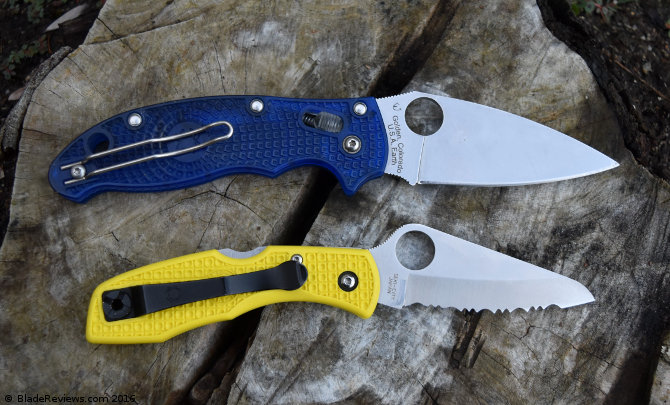
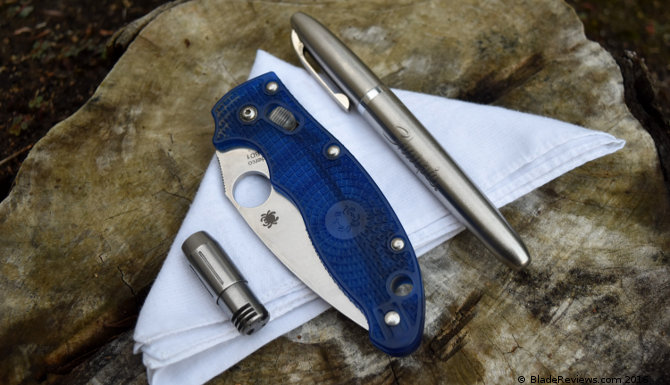

“Never fails to disappoint”
Perhaps you meant “never disappoints”
It was a little disconcerting to read, and reread. I figure you did not have anyone to edit your comments.
Hey Bob,
Thanks for pointing that out. Grayson does a great job editing his own reviews, and I read through it myself a couple times prior to publishing, but sometimes typos slip through the cracks. Regardless I appreciate your bringing this to my attention, and I’ve updated the review accordingly. Feel free to let me know if you catch anything else (on this review or any other on the website).
Best,
Dan
Thank you for bringing that up. I was particularly busy when writing this review, and it seems that that a few mistakes slipped through.
-Grayson
I use mine for hiking and paragliding, mainly due to the minimal weight. Personally, I could do without the choil as I find it makes more heavy cuts slightly more awkward. Either way it’s a good if not great knife, for me it comes down on ‘good’.
Hey Lew,
Thanks for the comment. On the whole, I’d agree. The Manix 2lw is an odd knife, in that it’s nice enough that I’d trust it to meet my needs, but not nice enough that I’m worried about abusing it. If I could just get the edge on the BD1 that I want, I’d be perfectly satisfied.
Thanks,
Grayson
A good review, but this knife has been reviewed so many times already that there is not much new to be said about it. Even as you were describing what you liked about the knife, I already knew what you were going to say. The same was true with the Victorinox Pioneer review. By contrast, I found the Viper Dan review to be really informative and interesting. It was a knife that was pretty out of the mainstream and I would probably have never come across, or at least never given it a second glance. But your enthusiasm for it was infectious, and by the end of the review it was on my wishlist. Hopefully the next knife you have up for review will be equally enthralling and off my radar.
Mike,
As always, your feedback is appreciated, but please allow me to interject to say that while it would be great if each review was of something novel and surprisingly good, the site is really designed to be a resource that encompasses all kinds of knives. Part of that mission involves reviewing classic pieces. If anything it forms the basis of a framework that we can use to compare other offerings. That is why I think it’s important to have reviews of stuff like the Pioneer, Griptilian, Delica, etc., interspersed with more esoteric stuff. Without that we really have no context.
And while the Manix 2 LW may be predictably good for those of us who live and breathe knives, the review will still prove useful to people newer to the hobby or those simply looking for a great, detailed, and long-term review of the Manix 2 LW.
Anyhow, none of this is meant to be overly defensive, but I also wanted to explain where we are coming from. Thanks again for the feedback.
Cheers,
Dan
As a vote of confidence, I like when a reviewer goes over a knife I’m quite familiar with. It gives me a better idea of the areas that I’ll agree or disagree with them on knives in general, and idea of the experience they possess, what they feel ideal ergonomics are, etc. I doubt I will ever find a reviewer I agree with 100% and their review of an unfamiliar blade doesn’t give me the same insight. It’s definitely more fun to read a review of a knife I don’t have experience with, but the reviews of industry standards adds tremendous value to the more novel reviews.
So by reviewing a “familiar knife” you can benchmark the reviewer themselves; get a sense of their likes, dislikes, tendencies, etc. It’s not something that I would have considered, but I can see that.
Yup! One immediate thing that I need to get a feel for is a reviewers take on ergonomics and, weirdly, the size of their hands. I wear XXL gloves which inevitably pushes me towards larger folders and folders with a poor blade to handle ratio. If a reviewer talks about the Mini Griptilian as ergonomic perfection I know almost immediately that I need to take their ergonomic opinions with a grain of salt, just because of physical differences between us.
Thanks, IM. Personally, I enjoy comparing notes with other people as well, but I also get that a review of a classic or heavily reviewed knife is usually less exciting than unearthing something new.
The goal is to have a good mix of both… at least until we exhaust every “classic” out there. 5 years into this project and there is still plenty of stuff that we haven’t reviewed! Thanks again.
Best,
Dan
This is why when a review of a knife for which I have some interest is posted here, EO, or EDC, I like to re-read a review of a knife that I already own and use to reacquire the feel of how the reviewer thinks.
Dan, that’s actually a double-edged sword of your multi-reviewer format(compared to EO or EDC anyways). On the one hand, and I wouldn’t change it at all, you get a diverse set of views and perspectives, and that’s very healthy; I hope it continues. On the other hand, it may take longer for a body of work to develop for any reviewers that aren’t yourself. But I think that’s a small negative for a lot of positive.
dpa,
Thanks for weighing in. I agree that it is very helpful to get a feel for the reviewers proclivities (and biases), as that naturally colors the review. And I agree – bringing on additional writers has been a great decision. It has taken things to another level.
Dan
A very good point about having this site as a resource with a wide breadth of knowledge. I guess with all the new contributors and the more frequent posts, I’ve gotten a bit spoiled.
Mike, Thank you. And it’s OK – I really appreciate the feedback, and will keep this in mind as we plan out which reviews to work on next.
Best,
Dan
I love my Manix 2 LW. In fact, I like it more than my PM2 simply for the blade shape, the pocket clip, and the weight.
Hey Dakota,
While those are all fair points, I don’t think the Manix2LW could keep the PM2 out of my pocket for long. Even if it could, I don’t think I would air that opinion here, for fear of losing all credibility with readers. 😛
Thanks,
Grayson
Respect the review Dan however having handled this lightweight version of the Manix 2 on numerous occasions it just could not convince me. The action isn’t great and certainly isn’t as smooth as the standard G10 Manix 2. The FRCP handle is squishy because it lacks liners. The handle material is semi-transcluscent(subjective, I know) and somewhat slippery which makes spydie flicking the knife awkward.
The Manix to get is the dark blue G10 and S110V version with skeletonized liners.
Hey Phil,
Thanks for commenting, but I think I need to respectfully disagree. I’ve owned this knife for 2+ years, and have never had a problem with the action. Deployment is smooth, with a heavier detent than similar locks.
I’m also a fan of the handle, as the G10 version is a brick in the pocket. I can understand why’d you’d prefer the heavier version, but for me it’s the LW version all the way.
Thanks again,
Grayson
While Manix 2 LW could be attractive to weight-conscious backpackers, I would prefer to have my Paramilitary 2 with me. Reasons?
1. It has much more usable and comfortable handle.
2. Steel liners allow using blade with a force (for example, for batoning or for some survival tasks)
3. While the tip is more fragile, it is more useful as a weapon in case some wild animal attacks
4. Larger spyderhole.
5. I feel that the pocket clip works better, and the knife is quite secure in tip-down carry. With wire clips I am afraid that the knife could fall out during the tree/rock climbing or similar activities.
6. Precision cuts.
I agree with a lot of your thinking. BD1 isn’t the greatest steel but corrosion resistance is high up on my list. If I have to constantly sharpen, maybe I should be using a box cutter etc..
I bought them when they first came out (BD1 and S110V).. There were a lot more complaints about the handle being cheap/sharp/boxy and locks hard to disengage.. I didn’t understand any of it…I’ve held many in store…I’ve carried and used the LWs a lot…
The handles are fine. The G10 CBB locks are smoother but the LWs are fine too..Great review and great knife.. IMO-Easily one of the best EDC knives..